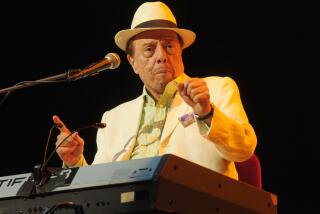A Pritzker surprise in Sao Paulo
- Share via
Paulo Mendes da Rocha, a Brazilian Modernist who has worked extensively in his home country for decades but had limited international exposure, has won the 2006 Pritzker Architecture Prize, the field’s highest honor. He will receive the $100,000 grant at a ceremony in Istanbul, Turkey, on May 30.
His work, which includes stadiums, museums and chapels, is marked by an integration with nature and muscular use of geometry, as in the concrete flying-saucer-like Paulistano Athletic Club in Sao Paulo. Many of these buildings, including his recently completed Patriarch Plaza, are in that city, where the architect lives with his wife.
“The prize surprised me, and is a great honor,” Mendes da Rocha, 77, said by phone from his home. “It’s very important for Latin American architects. It’s stimulating for our architecture and urban politics.”
The award, he said, carries a responsibility to the world community and inspired him to discuss his humanist and environmental concerns.
“In all the cities of the world we have this problem, the construction of a city for all. The presence of architects and urbanist opinion is very important right now, because of the fragility of nature.”
He said he hoped for the “formation of a popular culture around nature and ecology” as well as “worldwide solidarity” in solving problems. Despite the concentration of his work in Brazil, he said he did not believe in national boundaries for architecture.
The citation from the Pritzker jury praised him for his command of “the principles and language of Modernism,” as well as his “deep understanding of the poetics of space. He modifies the landscape and space with his architecture, striving to meet both social and aesthetic human needs.”
Jury chairman Lord Peter Palumbo said in a statement that the architect “brings the joyful lilt of Brazil to his work.” Juror Carlos Jimenez of Rice University praised his “profound social engagement” and “poetic rigor.”
Mendes da Rocha began his career in 1957 as part of Sao Paulo’s Modernist avant-garde, known as the Paulist Brutalist school, which involved a commitment to both rough concrete and ethical principles.
His first important projects included 1958’s bold Paulistano Athletic Club, a 2,000-capacity arena for which he also designed the elegant Paulistano chair, built around a single shaped steel bar.
The athletic club is “an epic building, which seems to hover like a spacecraft,” said Karen Stein, Phaidon Press’ editorial director and a jury member. “It’s very sculptural. These simple ideas, in some cases, seem to defy gravity, but they’re about elemental principles of engineering.” His signature, she said, is “the power of simplicity and strength.”
International recognition came when he designed his nation’s pavilion for the 1970 International Expo in Osaka, Japan, and upon receiving the Mies Van der Rohe Prize for Latin American Architecture in 2000. The new design for Patriarch Plaza, which has helped revive an urban space, with a suspended roof canopy and the redirection of car traffic, was completed in 2002.
Other projects include Sao Paulo’s sleek Forma Store, from 1987, and 1988’s Brazilian Museum of Sculpture, which is partly underground and built alongside an extensive garden.
Mendes da Rocha said his architectural inspiration came from his upbringing.
“I was born in a little harbor, and I was educated in front of the transformation of nature” as the area around the city of Vitoria evolved, he said. “It was a great human enterprise, like the building of Venice.”
The Pritzker, modeled on the Nobel Prize and funded by the Hyatt Foundation, has been awarded annually since 1979, when it recognized Philip Johnson. The 2005 award went to Thom Mayne, and the 2004 to Zaha Hadid. Although most recipients work internationally, a few, like 2002’s Glenn Murcutt of Australia, stay closer to home. Mendes da Rocha, who said he would prefer to work internationally but had had few offers, is Brazil’s second architect to win the honor, after Rio de Janeiro’s sculptural Modernist Oscar Niemeyer.
Mayne called Mendes da Rocha “a nice choice,” and recalled meeting him and touring his sculpture museum about a decade ago. He praised the Pritzker jury for choosing a noncelebrity.
“This is for serious architects, not businessmen. He’s not a People magazine guy,” he said. “They clearly want to keep this award diversified and international. He comes out of Corbusier. He’s really idiosyncratic, one of a kind, and more traditional” than most architects the jury considers.
Mayne guessed that Mendes da Rocha’s lack of projects outside Brazil was a result of his limited English and the fact that his longtime academic affiliation -- the University of Sao Paulo, from which he resigned for a decade during Brazil’s military dictatorship of the late ‘60s and ‘70s -- did not connect him with projects outside the nation’s borders.
Mendes da Rocha said he was proudest of the sculpture museum and the State Museum of Sao Paulo, a 1993 renovation of a classical-style 19th century building.
Current projects include the unconventional University of Vigo in Galicia, Spain, and an upcoming children’s science museum outside Sao Paulo.
Eric Owen Moss, president of the Southern California Institute of Architecture, said Mendes da Rocha worked in a “personal and expressive and exaggerated Modernism. It exaggerates and emphasizes the feats of engineering -- but in a sort of private way.”
Moss was heartened by the jury’s unpredictable choice.
“It suggests that the compass has rotated somewhere” away from Western Europe and the U.S., he said. “Here’s this old-fashioned model of someone like Gaudi, who barely set foot outside Barcelona. It stretches the world’s frame of reference: He hasn’t had to move physically to move the world internationally.”
More to Read
The biggest entertainment stories
Get our big stories about Hollywood, film, television, music, arts, culture and more right in your inbox as soon as they publish.
You may occasionally receive promotional content from the Los Angeles Times.










